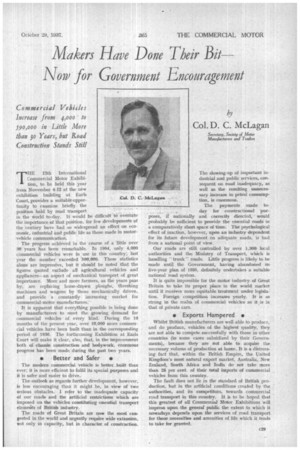Makers Have Done Their Bit--
Page 91

If you've noticed an error in this article please click here to report it so we can fix it.
AT ow for Government Encouragement
by
Col. D. C. McLagan
Secretary, Society of Motor Manufacturers and' Traders
Commercial Vehicles Increase from 4,000 to fpo,000 in Little More than 3o Years, but Road Construction Stands Still
THE 13th International Commercial Motor Exhibition, to be held this year from November 4-13 at the new exhibition building at Earls Court, provides a suitable opportunity to examine briefly the position held by road transport in the World to-day. It would be difficult to overrate the importance of that poSition, for few developments of the century have had _so widespread an effect on economic, industrial and public life as those made in motorvehicle communication.
The progress achieved in the course of a Tittle over 30 years has been remarkable. hi 1904, only 4,000 commercial vehicles were in use in this country., last year the number exceeded 590,000. These statistics alone are impressive, but it should be noted that the figures quoted exclude all agricultural vehicles and appliances—an aspect of mechanical transport of great importance. More and more farmers, as the years pass by, are rep/acing horse-drawn ploughs, threshing machines and wagons by those mechanically driven, and provide a constantly increasing market for commercial-motor manufacturers.
It is apparent that everything possible is being done by manufacturers to meet the growing demand for commercial vehicles of every kind. During the 10 months of the present year, over 10,000 more commercial vehicles have been built than in the corresponding period of 1935. The forthcoming Exhibition at Earls Court will make it clear, also, that, in the improvement both of chassis construction and bodywork, enormons progress has been made during the past two years.
• Better and Safer •
The modern commercial vehicle is better built than ever; it is more efficient to fulfil its special purposes and it is safer and easier to drive.
The outlook as regards further development, however, is less encouraging than it might be, in view of two serious obstacles. I refer to the inadequate capacity of our roads and the artificial restrictions which are imposed on the vehicles constituting essential transport elements of British industry.
The roads of Great Britain are now the most congested in the world and urgently require wide extension, not only in capacity, but in character of construction. The slowing-up of important industrial and public services, consequent on. road inadequacy, as well as the resulting unnecessary increase in petrol consumption, is enormous.
The payments made today for conetructional pun
poses, if nationally and correctly directed, would probably be sufficient to provide the essential roads in a comparatively short space of time. The psychological effect of inaction, however, -upon an industry dependent for its future development on adequate roads, is bad froin a national point of view.
Our roads are still controlled by over 1,300 local authorities and the Ministry of Transport, which is handling " trunk" roads. Little progress is likely to he in,ade until the Government, having abandoned its five-year plan of 1955, definitely undertakes a suitable national road system_
It is quite impossible for the motor industry of Great Britain to take its proper place in the world market until it receives more equitable treatment under legislation. Foreign. competition increases yearly. It is as strong in the realm. of commercial vehicles as it is is that of private cars.
• Exports Hampe red •
Whilst British manufacturers are well able to produce, and do produce, vehicles of the highest quality, they are not able to compete successfully with those in other countries (in some cases subsidized by their Governments), because they are not able to acquire the necessary volume of production at home. It is a distressing fact that, within the British Empire, the United Kingdom's most natural export market, Australia, New Zealand, South Africa and India do net take more than 28 per cent, of thei.r total imports of commercial vehicles from this couatry.
The fault does not lie in the standard of British production, hut in the artificial conditions created by the authorities, and its competitors, towards commercial road transport in this country. It is to be hoped that this greatest of all Commercial Motor Exhibitions will impress upon the general public the extent to which it nowadays depends upon the services of road transport. for those necessities and amenities of life which it tends to take for granted.
























































































































































































